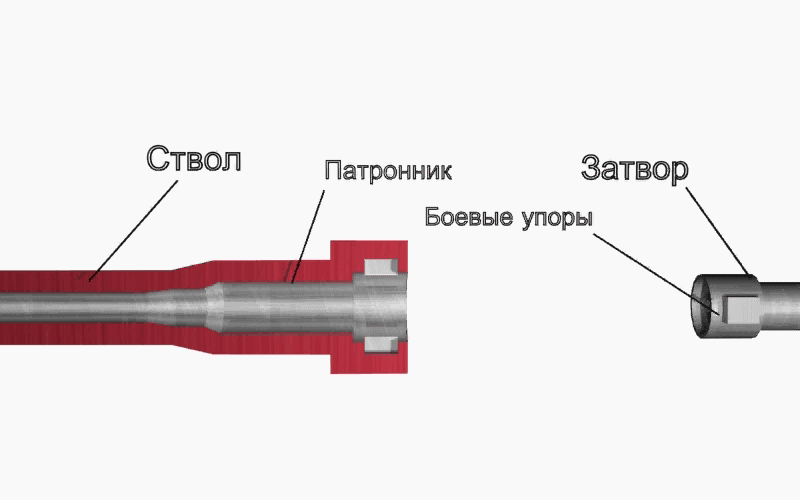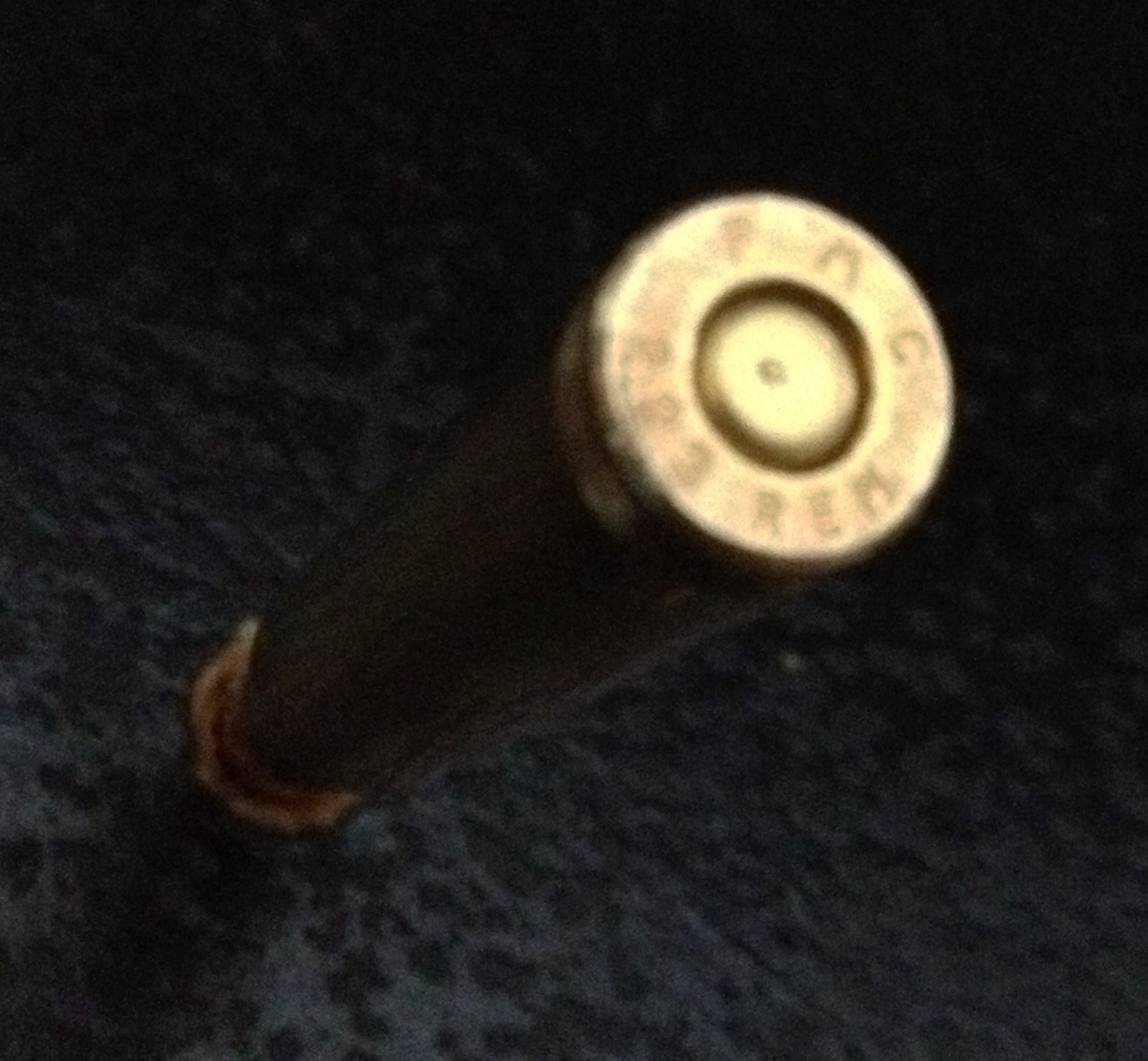Slamfire on:
[Wikipedia]
[Google]
[Amazon]
A slamfire is a discharge of a  Some military firearms are designed to fire from an
Some military firearms are designed to fire from an
 Firing pins intended to be activated by a trigger are either spring-loaded or free-floating. Both may move forward during the loading process when the face of the bolt hits the head of the chamber. Although the amount of forward movement is not intended to detonate the primer, slamfires occur when conditions do not match design assumptions.
Cartridges which may be entirely satisfactory in manually loaded firearms may be considered defective if they do not meet the design specifications of self-loading firearms. Primer depth is very important in
Firing pins intended to be activated by a trigger are either spring-loaded or free-floating. Both may move forward during the loading process when the face of the bolt hits the head of the chamber. Although the amount of forward movement is not intended to detonate the primer, slamfires occur when conditions do not match design assumptions.
Cartridges which may be entirely satisfactory in manually loaded firearms may be considered defective if they do not meet the design specifications of self-loading firearms. Primer depth is very important in
firearm
A firearm is any type of gun designed to be readily carried and used by an individual. The term is legally defined further in different countries (see Legal definitions).
The first firearms originated in 10th-century China, when bamboo tubes ...
occurring as a cartridge is being loaded into the chamber
Chamber or the chamber may refer to:
In government and organizations
*Chamber of commerce, an organization of business owners to promote commercial interests
*Legislative chamber, in politics
*Debate chamber, the space or room that houses deliber ...
. Some firearms are designed to slamfire, but the term also describes a malfunction of self-loading
A semi-automatic firearm, also called a self-loading or autoloading firearm (fully automatic and selective fire firearms are also variations on self-loading firearms), is a repeating firearm whose action mechanism ''automatically'' loads a follow ...
firearms. Shooters accustomed to firearms requiring trigger activation for discharge may be unprepared for a slamfire discharge.
 Some military firearms are designed to fire from an
Some military firearms are designed to fire from an open bolt
A firearm is said to fire from an open bolt if, when ready to fire, the bolt and working parts are held to the rear of the receiver, with no round in the chamber. When the trigger is actuated, the bolt travels forward, feeds a cartridge from t ...
condition to avoid unintended discharge of a chambered cartridge cooking off
Cooking off (or thermally induced firing) is unfired weapon ammunition exploding prematurely due to heat in the surrounding environment. The term is used both for detonation of ammunition not loaded into a weapon, and unintended firing of a loa ...
in a gun barrel heated by firing previous cartridges. Activating the trigger of such firearms releases the spring-loaded
A spring is an elastic object that stores mechanical energy. In everyday use the term often refers to coil springs, but there are many different spring designs. Modern springs are typically manufactured from spring steel, although some non- ...
bolt to move forward stripping a cartridge from the magazine
A magazine is a periodical publication, generally published on a regular schedule (often weekly or monthly), containing a variety of content. They are generally financed by advertising, purchase price, prepaid subscriptions, or by a combinatio ...
into the chamber. The firing pin impacts the primer
Primer may refer to:
Arts, entertainment, and media Films
* ''Primer'' (film), a 2004 feature film written and directed by Shane Carruth
* ''Primer'' (video), a documentary about the funk band Living Colour
Literature
* Primer (textbook), a te ...
as the cartridge is chambered, and the energy released by the discharging cartridge returns the bolt into an open position while ejecting the empty case.
Unintentional slamfire
More conventional self-loading firearms begin this cycle with a cartridge already in the chamber and await activation of the trigger to allow the firing pin to impact the primer, causing discharge and loading another cartridge into the chamber. The first cartridge must be loaded from the magazine by manually pulling back and then releasing the spring-loaded bolt to chamber the cartridge; and unintentional slamfires may occur if the firing pin activates the primer as the first cartridge is being chambered. Unintentional slamfires may also occur during the normal self-loading process following an intended discharge. Control of firing pin movement is the essential difference between cartridge discharge as the bolt closes, or discharge when the trigger is pulled. Firearms designed to discharge as the bolt closes may have a fixed firing pin or a firing pin which moves forward by inertia as forward motion of the bolt ceases when the cartridge is fully chambered, while more conventional firearms are designed to prevent the firing pin from impacting the primer until the trigger is pulled. Some unintentional slamfires are caused by firing pin malfunction, while others may be attributed to defective cartridges with improperly positioned or unexpectedly sensitive primers.Possible causes
 Firing pins intended to be activated by a trigger are either spring-loaded or free-floating. Both may move forward during the loading process when the face of the bolt hits the head of the chamber. Although the amount of forward movement is not intended to detonate the primer, slamfires occur when conditions do not match design assumptions.
Cartridges which may be entirely satisfactory in manually loaded firearms may be considered defective if they do not meet the design specifications of self-loading firearms. Primer depth is very important in
Firing pins intended to be activated by a trigger are either spring-loaded or free-floating. Both may move forward during the loading process when the face of the bolt hits the head of the chamber. Although the amount of forward movement is not intended to detonate the primer, slamfires occur when conditions do not match design assumptions.
Cartridges which may be entirely satisfactory in manually loaded firearms may be considered defective if they do not meet the design specifications of self-loading firearms. Primer depth is very important in centerfire ammunition
Two rounds of .357 Magnum, a centerfire cartridge; notice the circular primer in the center
A centerfire cartridge is a firearm metallic cartridge whose primer is located at the center of the base of its casing (i.e. "case head"). Unlike rim ...
. Most cartridges are assembled with the exposed surface of the primer a specified distance deeper than the base of the cartridge in contact with the bolt face. Primers with insufficient depth may be detonated by the normal amount of firing pin movement as the cartridge is chambered by forward bolt movement. Primer response to impact is a function of the thickness and hardness
In materials science, hardness (antonym: softness) is a measure of the resistance to localized plastic deformation induced by either mechanical indentation or abrasion. In general, different materials differ in their hardness; for example hard ...
of the metal cup containing the detonating explosive. Primers intended to respond to the comparatively light firing pin impact of older or smaller manually-loaded firearms may be initiated by the relatively energetic self-loading process necessary to reliably chamber cartridges. Most military ammunition makes use of hard primers unlikely to be detonated by a comparatively light inertial strike. The NATO
The North Atlantic Treaty Organization (NATO, ; french: Organisation du traité de l'Atlantique nord, ), also called the North Atlantic Alliance, is an intergovernmental military alliance between 30 member states – 28 European and two N ...
military alliance uses NATO specific standardization agreement (STANAG)s that define the minimal and maximal allowed primer sensitivity for small arms ammunition. For 5.56×45mm NATO ammunition STANAG 4172, among a considerable number of technical requirements, specifies the permissible primer sensitivity range for 5.56×45mm NATO ammunition.
Spring-loaded firing pins may move further forward than expected during the loading process if the restraining spring is broken or weakened by age. As rust, dirt, fouling, or inappropriately viscous
The viscosity of a fluid is a measure of its resistance to deformation at a given rate. For liquids, it corresponds to the informal concept of "thickness": for example, syrup has a higher viscosity than water.
Viscosity quantifies the in ...
lubricant
A lubricant (sometimes shortened to lube) is a substance that helps to reduce friction between surfaces in mutual contact, which ultimately reduces the heat generated when the surfaces move. It may also have the function of transmitting forces, t ...
s accumulate in the firing pin channel, both free-floating and spring-loaded firing pins may be held in a forward position protruding from the bolt face. While rust prevention is important, wet lubricants can trap carbon and other pollutants from burning propellant, so avoidance of excess lubrication reduces the risk of slam fires from firing pins becoming stuck forward.
Anything adhering to the tip of a firing pin or the portion of the bolt face behind the primer may cause unexpectedly heavy primer contact during the self-loading process. The larger priming compound distribution area of rimfire ammunition
Rimfire ammunition is a type of firearm metallic cartridge whose primer is located within a hollow circumferential rim protruding from the base of its casing. When fired, the gun's firing pin will strike and crush the rim against the edge ...
increases the number of locations where dirt or fouling on the bolt face or in the rim portion of the firearm chamber may deform the cartridge rim enough to function as a firing pin during the self-loading process.
Risks
Unintended slamfires are dangerous, and recoil may cause shooters to lose control of light firearms with conditions causing sequential slamfires if a normally semi-automatic firearm "goes full-auto" unexpectedly. A single defective cartridge may cause a single slamfire, but a firing pin stuck in a forward position or a magazine loaded with defective ammunition may cause a round to fire every time the bolt closes until the magazine is empty. Shooters must keep the firearm pointed in a safe direction ("downrange") while closing the bolt and chambering a cartridge. If a slamfire does occur, the shooter must do his or her best to hold the firearm securely pointed in a safe direction until it ceases firing. This requires discipline, because untrained shooters may become surprised and instinctively drop the firearm as soon as it begins firing. Aside from the dangers of any accidental discharge, an out-of-battery ignition may occur if a round slamfires before it is completely secured in the chamber. The firearm may be damaged or destroyed by a breech explosion potentially injuring the shooter and bystanders.Intentional slamfire designs
Pipe guns use a free floatinggun barrel
A gun barrel is a crucial part of gun-type weapons such as small firearms, artillery pieces, and air guns. It is the straight shooting tube, usually made of rigid high-strength metal, through which a contained rapid expansion of high-pres ...
with a rimmed cartridge
A rim is an external flange that is machined, cast, molded, stamped, or pressed around the bottom of a firearms cartridge. Thus, rimmed cartridges are sometimes called "flanged" cartridges. Almost all cartridges feature an extractor or headspacing ...
(often a shotgun shell
A shotgun shell, shotshell or simply shell is a type of rim (firearms), rimmed, cylindrical (straight-walled) cartridge (firearms), cartridges used specifically in shotguns, and is typically loaded with numerous small, pellets (petrology), pellet ...
) inserted in the breech, sliding within a pipe functioning as a tubular receiver with a fixed firing pin in the back. No trigger or lockwork is required, because the loaded barrel is simply inserted into the pipe and slammed backward to fire.
See also
* Firearm malfunction * Recoil operation * Bump stockReferences
{{Reflist Firearm terminology